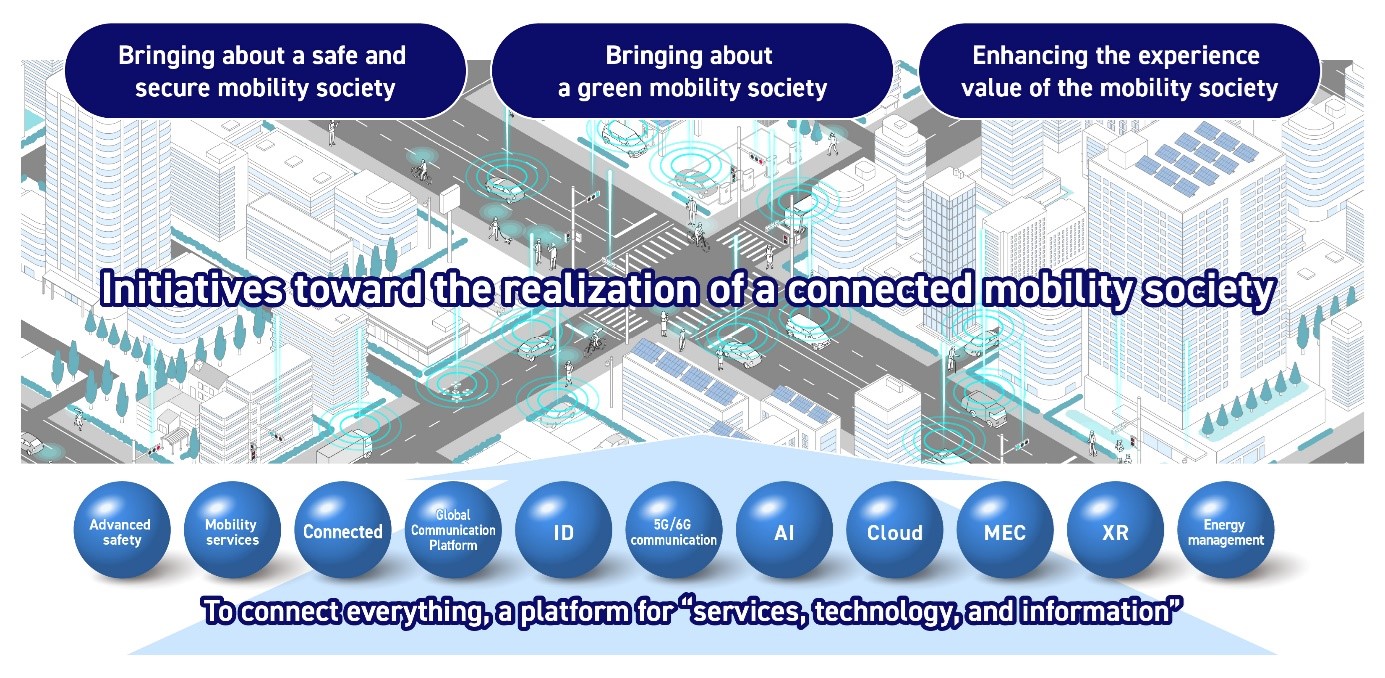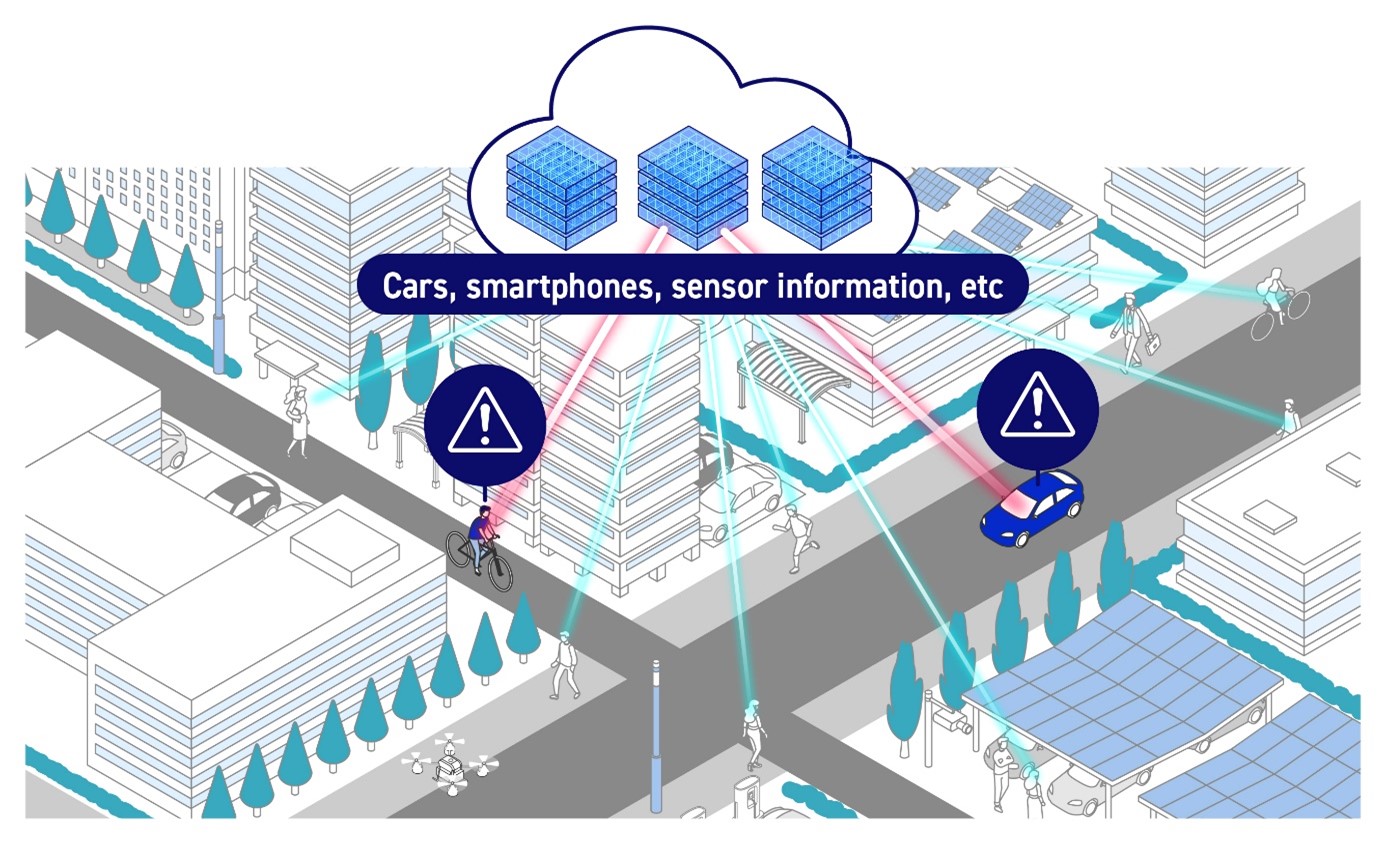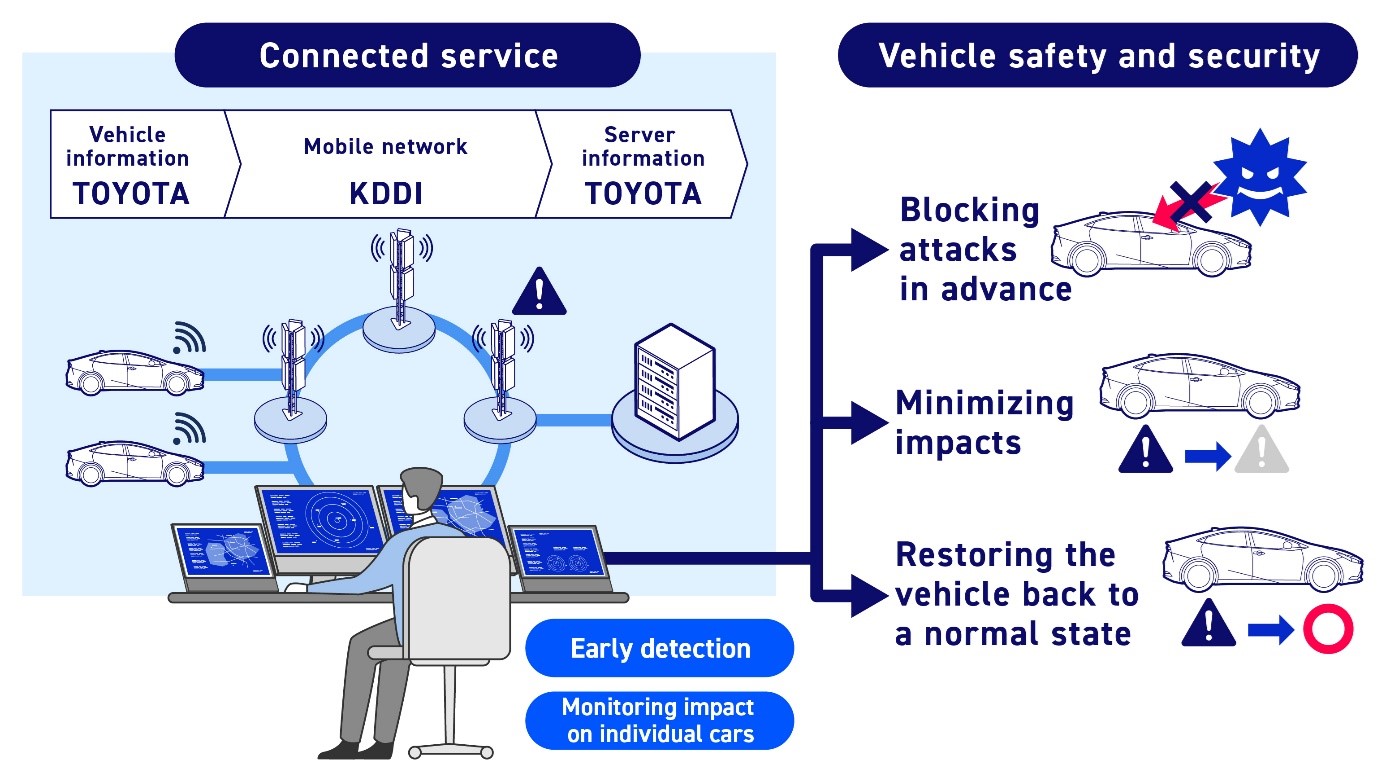―Collaborating with Toyota for the early implementation of a safe and secure mobility society―
KDDI CORPORATION
Tokyo, February 20, 2024―Utilizing IoT and other resources, KDDI is advancing initiatives towards the realization of a connected mobility society.
Collaborating with Toyota Motor Corporation (hereinafter "Toyota"), KDDI will start providing a solution (hereinafter "risky place scoring") in spring 2024 as an initiative to bring about a safe and secure mobility society. This solution involves big data of people and vehicle movements as well as open data, such as past traffic accident information, which is analyzed by AI to visualize risky places.
Since October 30, 2020, the companies have aimed to realize a society in which towns, homes, people, and vehicles are all connected, and they are jointly working on "research and development of communication technologies and connected car technologies" as well as "development of services that enrich people's lives." With an understanding of the current situation with respect to mobility, the companies are advancing initiatives for social implementation of these technologies under the themes of "bringing about a safe and secure mobility society," "bringing about a green mobility society," and "enhancing the value of mobility experiences."

<Big picture of the initiatives by KDDI and Toyota towards the realization of a connected mobility society>
■Backgrounds and concepts of the themes
1. Bringing about a safe and secure mobility society
(Background)
In 2022, there were approximately 300,000 traffic accidents, 40% of which were accidents resulting from being unable to see ahead clearly [![]() 1], drawing attention to the need to avoid accidents that are difficult to prevent solely by using alarms and "Autonomous Emergency Braking System" with automotive sensors. In 2035, connected cars are expected to double in number compared to 2023, which also calls for enhanced security to protect against systems that are becoming ever more complex.
1], drawing attention to the need to avoid accidents that are difficult to prevent solely by using alarms and "Autonomous Emergency Braking System" with automotive sensors. In 2035, connected cars are expected to double in number compared to 2023, which also calls for enhanced security to protect against systems that are becoming ever more complex.
(Concept)
Utilizing digital twins generated from KDDI's human travel data, Toyota's vehicle data, and open data such as the number of past traffic accidents, the parties will contribute to safe and secure community-building and traffic safety. Also, the solution will connect operational information for connected services such as those for vehicles, networks, and servers across different domains to understand every car's situation in order to identify the range of effects from connected services provided by communicative vehicles, thereby contributing to the realization of safe, secure connected services.
2. Bringing about a green mobility society
(Background)
To combat climate change, efforts to reduce CO2 emissions are moving forward around the world.
As the number of connected cars increases, there is a need to reduce their power use as well as to utilize renewable energy to power connected cars' data processing.
(Concept)
We will process large amounts of data accumulated from the spread of connected cars at network edges close to connected cars. We will do so in immersed containers to reduce power use.
To maximize renewable energy utilization, we will transfer necessary data to center servers by prioritizing servers using renewable energy.
Through these efforts, we will contribute to reducing CO2 emissions.
3. Enhancing the value of mobility experiences
(Background)
At present, mobility experiences are being called for not just while one is travelling but while one is inside the car before and after travelling; such experiences should seamlessly connect the inside of the car with one's living space, featuring optimized communication that serves the customer's intended usage.
(Concept)
KDDI and Toyota will combine their services and state-of-the-art technologies to realize a new mobility experience, including by enriching the time spent inside the car and making travel more fun. To support these experiences, the parties will aim to provide optimal communication that serves customer needs, which change by place and time, as customers travel; this will be done using not only cellular communication but also other means such as satellite and Wi-Fi communication.
Going forward, KDDI and Toyota will combine their services, technologies, and information to advance research and development as well as service development for a connected mobility society.
For more details, please refer to the attachment.
<Attachment>
Under the theme of "bringing about a safe and secure mobility society," KDDI and Toyota are advancing efforts to implement in society "risky place scoring," "Vehicle to Bike, a system for alerting drivers with car and bicycle location information," and "connected monitoring centers."
■Risky place scoring
1. Overview
This system scores risky places and visualizes them by AI analysis of KDDI's location information collected in 10-m increments at intervals as short as several minutes, user attribute information (gender and age) from personal identification data from smartphone signups [![]() 2], Toyota's probe data and automotive network data (CAN data) [
2], Toyota's probe data and automotive network data (CAN data) [![]() 3], and open data such as road features and the number of traffic accidents. The system visualizes risk levels in grids consisting of approximately 50-m cells and allows users to see the risk factors such as the ratio of elderly pedestrians and elderly cyclists and the proportion of suddenly braking cars in target locations, thus enabling the system to be utilized for various traffic safety work, including data-based devising of effective traffic measures (such as needs for installing new road signs).
3], and open data such as road features and the number of traffic accidents. The system visualizes risk levels in grids consisting of approximately 50-m cells and allows users to see the risk factors such as the ratio of elderly pedestrians and elderly cyclists and the proportion of suddenly braking cars in target locations, thus enabling the system to be utilized for various traffic safety work, including data-based devising of effective traffic measures (such as needs for installing new road signs).
2. Data used

<Risky place scoring>
■"Vehicle to Bike," an alert system utilizing location information of cars and bicycles
1. Overview
"Vehicle to X" is a solution that enables interactions and connections between cars and various things. As the first step towards implementation, KDDI and Toyota are developing a technology that utilizes the location information of cars and two-wheeled vehicles [![]() 4] to alert drivers in advance when multiple vehicles simultaneously approach a risky intersection. The system is designed to contribute to traffic safety at intersections with poor visibility by means of smartphone beeps, vibrations, and alert screens in order to prevent accidents that are difficult to prevent with alerts from automotive sensors and "Autonomous Emergency Braking System" alone.
4] to alert drivers in advance when multiple vehicles simultaneously approach a risky intersection. The system is designed to contribute to traffic safety at intersections with poor visibility by means of smartphone beeps, vibrations, and alert screens in order to prevent accidents that are difficult to prevent with alerts from automotive sensors and "Autonomous Emergency Braking System" alone.
Going forward, the parties will continue this research and development as well as service development for future implementation in society.
2. Details
To alert drivers to brake while they still have plenty of room ahead, we have achieved low latency by making the search process lightweight and speeding up the logic that detects simultaneously approaching vehicles. Combined with risky place scoring, this system alerts drivers only at risky intersections in order to avoid becoming bothersome and changes the frequency of location information updates according to the distance from risky intersections in order to conserve smartphone battery life.
From February 1 to 28, 2023, we conducted a verification test on a public road in Itabashi, Tokyo, confirming that drivers' speed of entry into the intersection was reduced by 10.1 km/h on average.

<Alerting drivers of approaching vehicles using location information of vehicles and bicycles>
■Connected monitoring centers
To bring about safe and secure connected services, we will connect connected-car operating information such as KDDI's network information and Toyota's vehicle and server information; and we will be able to monitor each car's state by horizontally linking such information, allowing us to identify the range of impacts to the connected services provided to connected cars with communication functions.
Through this effort, we will detect abnormal communication patterns, such as attacks via administrative servers and attacks using vehicles, thereby reducing and avoiding impacts on individual cars, which was not possible before.
Going forward, we will conduct evaluations ahead of the full launch and aim to apply this solution on a Global Communication Platform [![]() 5].
5].

<Connected monitoring centers>
■Future initiatives
On February 5, 2024, under the theme of "bringing about a green mobility society," the parties opened a small data center that utilizes immersive cooling technologies, and they have been conducting a field experiment to process large amounts of data on the network edge.
Furthermore, from February 20 to May 31, 2024, we will conduct a trial under the theme of "enhancing the value of mobility experiences." This will include the communication-based road-trip planning service "Design Your Road Trip," which allows friends and acquaintances to edit plans jointly, and an AR glass monitoring service.
To find out more about the trial service for "Design Your Road Trip," visit:
- *The information contained in the articles is current at the time of publication.
Products, service fees, service content and specifications, contact information, and other details are subject to change without notice.